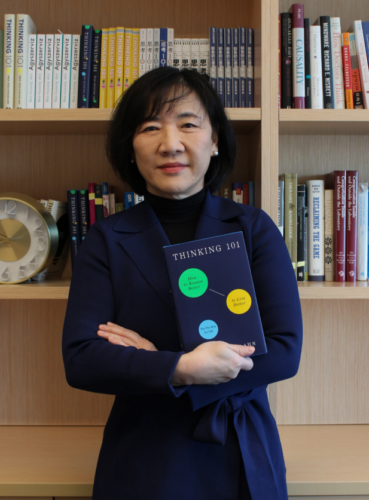Photography by Rachel Mak
In Thinking 101: How to Reason Better to Live Better, Yale psychology professor Woo-kyoung Ahn explores cognitive fallacies and biases that shape and distort our decision-making. Ahn, who teaches one of Yale’s most popular classes, “Thinking,” wrote the book in response to the overwhelming demand and curiosity for its lessons on cognitive processes. She argues that these thinking errors are not individual shortcomings but rather natural byproducts of human biology. By framing these biases in the context of everyday life, Thinking 101 offers guidance for her readers to take control of their minds and decisions.
One of the most pervasive cognitive biases Ahn examines in the book is confirmation bias, the tendency to seek information that confirms one’s preexisting beliefs. This bias is more than just a misinterpretation—it can actively shape behavior. For instance, Ahn presents the example of self-diagnosing social anxiety. If someone believes they are socially anxious, they may selectively focus on moments of discomfort while discounting signs of social competence. Over time, this self-reinforcing belief can lead to avoiding social situations altogether, deepening the very anxiety that was the source of fear. Since such cases of confirmation bias are so prevalent, we must remain skeptical of our assumptions and consider alternative explanations, even when they challenge our intuitions.
Another cognitive trap Ahn discusses is our tendency to be overly influenced by vivid examples. People respond more strongly to specific emotionally charged visuals than mere abstract ideas and definitions. Ahn discusses this power in the context of donations, where people are more likely to donate to charity when presented with a specific famine victim’s story rather than a broad statistic regarding the food crisis. This phenomenon also takes shape in a different way in many young people’s lives today. Adolescents scrolling through Instagram, for instance, may be disproportionately affected by a carefully curated, polished post, leading them to believe that others’ lives are far more perfect than their own.
Recognizing cognitive biases is a necessary first step in addressing them, but it is not enough on its own. We must continue to surveil our minds for flawed assumptions and conclusions. “One must be prepared to be wrong,” Ahn writes. Breaking out of familiar thinking patterns is not a passive process, as it requires an uncomfortable consideration of alternatives. Ahn encourages her students to choose small unconventional tasks as a way to practice stepping out of one’s comfort zones. By cultivating awareness and embracing discomfort, individuals can reclaim control over their reasoning and reshape the narratives that define their lives.

